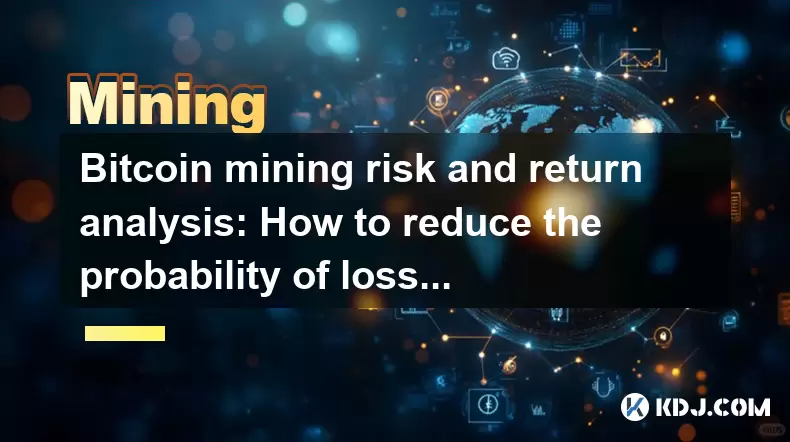-
 bitcoin
bitcoin $118548.520763 USD
3.67% -
 ethereum
ethereum $4352.564943 USD
4.79% -
 xrp
xrp $2.964058 USD
4.22% -
 tether
tether $1.000565 USD
0.05% -
 bnb
bnb $1028.372955 USD
1.46% -
 solana
solana $221.373507 USD
6.00% -
 usd-coin
usd-coin $0.999933 USD
0.02% -
 dogecoin
dogecoin $0.248633 USD
6.85% -
 tron
tron $0.341444 USD
2.38% -
 cardano
cardano $0.852946 USD
5.82% -
 hyperliquid
hyperliquid $47.869306 USD
6.15% -
 chainlink
chainlink $22.561476 USD
6.01% -
 ethena-usde
ethena-usde $1.001258 USD
0.05% -
 avalanche
avalanche $30.660000 USD
2.06% -
 stellar
stellar $0.400917 USD
9.76%
Bitcoin mining risk and return analysis: How to reduce the probability of loss?
Bitcoin mining offers high returns but comes with risks like hardware costs, electricity expenses, and market volatility; strategies like joining pools and using efficient hardware can mitigate these.
Jun 08, 2025 at 10:50 pm

Bitcoin mining has become an increasingly popular venture within the cryptocurrency space, driven by the potential for high returns. However, like any investment, it comes with its own set of risks. Understanding these risks and learning how to mitigate them is crucial for anyone considering entering the Bitcoin mining industry. This article will delve into the risk and return analysis of Bitcoin mining and provide strategies to reduce the probability of loss.
Understanding Bitcoin Mining
Bitcoin mining is the process by which new bitcoins are introduced into circulation and transactions are verified and added to the blockchain. Miners use specialized computer hardware to solve complex mathematical problems, and in return, they are rewarded with bitcoins. The process is competitive, and the difficulty of the problems adjusts periodically to ensure a steady rate of new bitcoins being added to the supply.
Risks Involved in Bitcoin Mining
There are several risks associated with Bitcoin mining that potential miners should be aware of. These include:
Hardware Costs and Depreciation: The initial investment in mining hardware can be significant. Moreover, the rapid advancement in technology means that mining equipment can become obsolete quickly, leading to depreciation.
Electricity Costs: Mining consumes a substantial amount of electricity. Depending on the location and the cost of electricity, this can significantly impact the profitability of mining operations.
Regulatory Risks: The legal status of Bitcoin and mining varies by country. Changes in regulations can affect the ability to mine or the value of mined bitcoins.
Market Volatility: The price of Bitcoin can be highly volatile, which directly impacts the value of the mining rewards. A drop in Bitcoin's price can turn a profitable operation into a loss-making one.
Operational Risks: These include hardware failures, theft, and cybersecurity threats. Mining operations require constant monitoring and maintenance to ensure they run smoothly.
Returns from Bitcoin Mining
The primary return from Bitcoin mining is the block reward, which is the number of bitcoins awarded to the miner who successfully adds a block to the blockchain. Additionally, miners earn transaction fees from the transactions included in the block they mine. The total return from mining depends on several factors, including the price of Bitcoin, the efficiency of the mining hardware, and the cost of electricity.
Strategies to Reduce the Probability of Loss
To mitigate the risks associated with Bitcoin mining and improve the chances of profitability, consider the following strategies:
Choose the Right Hardware: Investing in the latest and most efficient mining hardware can reduce electricity costs and improve the chances of solving the mathematical problems faster. Research and compare different models to find the best fit for your budget and needs.
Optimize Electricity Costs: Look for locations with low electricity rates or consider renewable energy sources like solar or wind power. Some miners even relocate their operations to areas with cheaper electricity to maximize profits.
Join a Mining Pool: Joining a mining pool can provide a more consistent income stream. While the rewards are shared among pool members, it reduces the variance in earnings and provides a more predictable return.
Stay Informed About Regulations: Keep abreast of the latest regulatory changes in your country and globally. Understanding the legal landscape can help you adapt your mining operations to comply with new laws and avoid potential shutdowns.
Diversify Your Investments: Don't put all your resources into mining. Consider diversifying your investments within the cryptocurrency space or into other asset classes to spread the risk.
Implement Robust Security Measures: Protect your mining operation from theft and cyber-attacks. Use secure wallets, implement multi-factor authentication, and regularly update your software to guard against vulnerabilities.
Monitor and Adjust: Continuously monitor the performance of your mining operation and adjust your strategy as needed. This includes keeping an eye on the market price of Bitcoin, the difficulty level of mining, and the health of your hardware.
Analyzing the Cost-Benefit Ratio
To determine whether Bitcoin mining is a viable venture, it's essential to conduct a thorough cost-benefit analysis. Calculate the total costs, including hardware, electricity, and any other operational expenses. Then, estimate the potential returns based on current Bitcoin prices and mining difficulty. Use this analysis to decide whether the potential returns justify the risks and costs involved.
Case Studies of Successful and Unsuccessful Mining Operations
Examining real-world examples can provide valuable insights into what works and what doesn't in Bitcoin mining. Successful mining operations often share common traits such as efficient hardware, low electricity costs, and effective risk management strategies. On the other hand, unsuccessful operations typically suffer from high costs, regulatory issues, or poor planning. Studying these case studies can help you learn from others' experiences and apply those lessons to your own mining venture.
Frequently Asked Questions
Q: Can I start Bitcoin mining with a regular computer?A: While it is technically possible to mine Bitcoin with a regular computer, it is not practical or profitable. Bitcoin mining requires specialized hardware known as ASICs (Application-Specific Integrated Circuits) to be competitive in the current mining landscape.
Q: How long does it take to break even on a Bitcoin mining investment?A: The time it takes to break even on a Bitcoin mining investment varies widely depending on factors such as the cost of hardware, electricity rates, and the price of Bitcoin. It could take anywhere from a few months to a year or more to recoup your initial investment.
Q: Is it better to mine Bitcoin alone or join a mining pool?A: Joining a mining pool is generally more beneficial for individual miners. While the rewards are shared, mining pools offer a more consistent income stream and reduce the variance in earnings, making it easier to plan and manage your mining operation.
Q: What are the environmental impacts of Bitcoin mining?A: Bitcoin mining consumes a significant amount of electricity, which can have a substantial environmental impact depending on the source of the power. Miners using renewable energy sources can mitigate these impacts, but overall, the carbon footprint of Bitcoin mining is a topic of ongoing debate and concern within the cryptocurrency community.
Disclaimer:info@kdj.com
The information provided is not trading advice. kdj.com does not assume any responsibility for any investments made based on the information provided in this article. Cryptocurrencies are highly volatile and it is highly recommended that you invest with caution after thorough research!
If you believe that the content used on this website infringes your copyright, please contact us immediately (info@kdj.com) and we will delete it promptly.
- BlockDAG, DOGE, HYPE Sponsorship: Crypto Trends Shaping 2025
- 2025-10-01 00:25:13
- Deutsche Börse and Circle: A StableCoin Adoption Powerhouse in Europe
- 2025-10-01 00:25:13
- BlockDAG's Presale Buzz: Is It the Crypto to Watch in October 2025?
- 2025-10-01 00:30:13
- Bitcoin, Crypto, and IQ: When Genius Meets Digital Gold?
- 2025-10-01 00:30:13
- Stablecoins, American Innovation, and Wallet Tokens: The Next Frontier
- 2025-10-01 00:35:12
- NBU, Coins, and Crypto in Ukraine: A New Yorker's Take
- 2025-10-01 00:45:14
Related knowledge

The difference between staking and mining
Sep 24,2025 at 05:18am
Understanding Staking in the Cryptocurrency Ecosystem1. Staking involves holding funds in a cryptocurrency wallet to support the operations of a block...

How to participate in testnet mining?
Sep 22,2025 at 09:18am
Understanding Testnet Mining in the Crypto Ecosystem1. Testnet mining is a method used by blockchain developers to simulate real-world conditions on a...

How to dispose of abandoned mining machines?
Sep 19,2025 at 08:19pm
Assessing the Condition of Abandoned Mining Rigs1. Begin by inspecting each mining machine for visible damage, corrosion, or missing components. Machi...

How to identify high-quality mining pools?
Sep 21,2025 at 03:19pm
Reputation and Track Record1. A mining pool’s reputation is built over time through consistent performance and transparency. Pools that have operated ...

Advantages of decentralized mining pools
Sep 20,2025 at 04:36pm
Enhanced Security and Resistance to Censorship1. Decentralized mining pools operate on blockchain-based smart contracts, eliminating the need for a ce...

What is mining machine overclocking?
Sep 21,2025 at 07:19pm
Understanding Mining Machine Overclocking1. Mining machine overclocking refers to the process of increasing the operating frequency of a cryptocurrenc...

The difference between staking and mining
Sep 24,2025 at 05:18am
Understanding Staking in the Cryptocurrency Ecosystem1. Staking involves holding funds in a cryptocurrency wallet to support the operations of a block...

How to participate in testnet mining?
Sep 22,2025 at 09:18am
Understanding Testnet Mining in the Crypto Ecosystem1. Testnet mining is a method used by blockchain developers to simulate real-world conditions on a...

How to dispose of abandoned mining machines?
Sep 19,2025 at 08:19pm
Assessing the Condition of Abandoned Mining Rigs1. Begin by inspecting each mining machine for visible damage, corrosion, or missing components. Machi...

How to identify high-quality mining pools?
Sep 21,2025 at 03:19pm
Reputation and Track Record1. A mining pool’s reputation is built over time through consistent performance and transparency. Pools that have operated ...

Advantages of decentralized mining pools
Sep 20,2025 at 04:36pm
Enhanced Security and Resistance to Censorship1. Decentralized mining pools operate on blockchain-based smart contracts, eliminating the need for a ce...

What is mining machine overclocking?
Sep 21,2025 at 07:19pm
Understanding Mining Machine Overclocking1. Mining machine overclocking refers to the process of increasing the operating frequency of a cryptocurrenc...
See all articles










































































